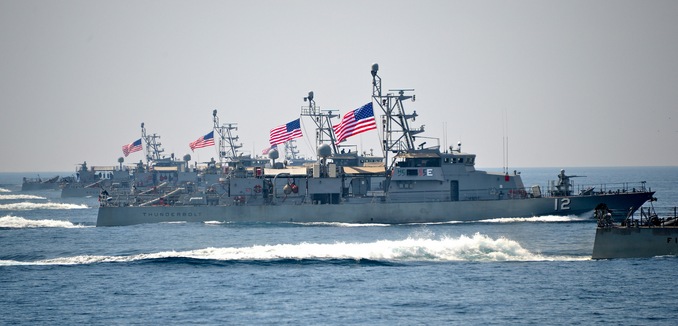An Iranian boat came within 150 yards of the USS Thunderbolt in the northern Persian Gulf on Tuesday, prompting the American vessel to fire warning shots near the advancing craft.
The Thunderbolt, a patrol boat that had been accompanying the cruiser USS Vella Gulf and two U.S. Coast Guard vessels, fired at the Islamic Revolutionary Guard Corps Navy vessel at about 3 PM local time, the Navy Times reported.
“It is out of the norm for them to come in that close at that rate of speed,” an anonymous defense official said. “We had to act for the safety of the crew.”
The Thunderbolt issued radio calls, fired flares, and sounded sirens—an internationally recognized signal of danger—before finally firing in the water, the Associated Press reported. After the shots were fired, the Iranian boat went “dead in the water,” a U.S. defense official told the AP. All ships left the area with no further incident.
In April of this year, an Iranian vessel came within 1,000 yards of the USS Mahan with its weapons manned, prompting the U.S. destroyer to alter its course, sound a danger alarm, fire flares, and man its weapons. In January, the Mahan was forced to fire when four smaller Iranian vessels approached at unsafe speed with their weapons manned.
According to the U.S. military, Iranian vessels instigated at least 35 “unprofessional” encounters with U.S. naval vessels in the Persian Gulf during 2016, a 50 percent increase from 2015, Fox News reported in April.
Iran’s aggression in the Persian Gulf marks a continuing challenge to America’s naval presence and its commitment to keep the area open to international shipping.
The IRGC captured ten American sailors and two boats in January 2016, an incident that then Secretary of Defense Ashton Carter called “outrageous, unprofessional and inconsistent with international law.” Chief of Naval Operations Adm. John Richardson echoed Carter’s assessment when announcing the result of the Navy’s investigation into the seizure in June 2016. “Those boats and crewmembers had every right to be where they were that day,” Richardson said. “The investigation concluded that Iran violated international law by impeding the boats’ innocent passage transit, and they violated our sovereign immunity by boarding, searching, and seizing the boats, and by photographing and video recording the crew.”
The U.S. Navy reported last July that in 2015, there were close to 300 encounters or “interactions” between American and Iranian naval vessels in the Persian Gulf. While most of the encounters were not considered to be harassment, the behavior of the Iranian navy was found to be less disciplined than that of other navies. Lt. Forrest Griggs, the operations officer of the USS New Orleans, explained that risks arise from the unpredictable behavior and uncertain intent of the Iranian vessels. “It’s very common for them to come up to within 300, 500 yards of us, and then they’ll turn, or parallel us and stop,” he said.
In December 2015, an IRGC boat fired rockets within 1,500 yards of the USS Harry S Truman, an action that was termed “highly provocative” by U.S. Central Command spokesman Cmdr. Kyle Raines. In April 2015, Iran seized the Marshall Islands-flagged Maersk Tigris and held it for ten days in violation of international law. The next month, Iranian vessels fired on a Singapore-flagged cargo ship after it refused to sail into Iranian waters, desisting only after the United Arab Emirates dispatched coast guard boats to help the distressed ship.
An Iranian surveillance aircraft came unusually close to a Navy helicopter from the USS Carl Vinson in March 2015, a month after the IRGC sunk a mock U.S. aircraft carrier during military exercises. The exercises were broadcast on state television with a quote attributed to the first leader of the Islamic Republic, Ayatollah Ruhollah Khomeini: “If the Americans are ready to be buried at the bottom of the waters of the Persian Gulf—so be it.” A year before, Iran broadcast a simulation of its forces attacking Israel and the American aircraft carrier USS Abraham Lincoln on state television.
Vice Admiral Kevin Donegan, the commander of the U.S. Navy’s Fifth Fleet, observed in November 2015 that Iran’s “malign behavior” at sea had not changed since the announcement of the nuclear deal four months earlier.
[Photo: DVIDSHUB / Flickr]




